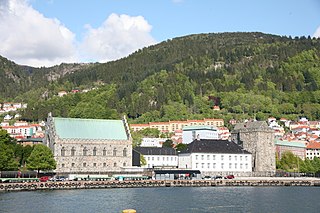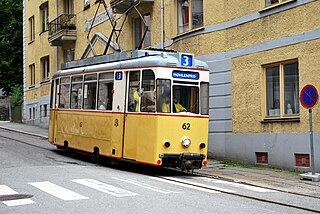You can help expand this article with text translated from the corresponding article in Norwegian. (November 2024)Click [show] for important translation instructions.
|

An explosion occurred in Bergen, Norway on 20 April 1944.
You can help expand this article with text translated from the corresponding article in Norwegian. (November 2024)Click [show] for important translation instructions.
|

An explosion occurred in Bergen, Norway on 20 April 1944.
The Dutch vessel ST Voorbode loaded with 273,000 lb of explosives caught fire and exploded by the quay in the center of Bergen Vågen at 08:39. 158 people (including 98 civilians) were killed and some 4,800 wounded. 131 houses were destroyed outright, while 117 were so damaged that they had to be condemned.
Following the explosion 4,260 children were evacuated. Important cultural buildings, including Nykirken, the Customs House, Bryggen, the Rosenkrantz Tower and the Haakon's Hall, were severely damaged, but have later been restored.

Bergen, historically Bjørgvin, is a city and municipality in Vestland county on the west coast of Norway. As of 2022, its population was roughly 289,330. Bergen is the second-largest city in Norway after the national capital Oslo. The municipality covers 465 square kilometres (180 sq mi) and is located on the peninsula of Bergenshalvøyen. The city centre and northern neighbourhoods are on Byfjorden, 'the city fjord'. The city is surrounded by mountains, causing Bergen to be called the "city of seven mountains". Many of the extra-municipal suburbs are on islands. Bergen is the administrative centre of Vestland county. The city consists of eight boroughs: Arna, Bergenhus, Fana, Fyllingsdalen, Laksevåg, Ytrebygda, Årstad, and Åsane.

Alrekstad was one of the largest Kongsgård estates on the west coast of Norway during the early Middle Ages.

Bryggen, also known as Tyskebryggen, is a series of Hanseatic heritage commercial buildings lining up the eastern side of the Vågen harbour in the city of Bergen, Norway. Bryggen has been on the UNESCO list for World Cultural Heritage sites since 1979.

Bergenhus is a borough of the city of Bergen in Vestland county, Norway. This borough encompasses the city centre and is the most urbanized area of the whole city. The 25.41-square-kilometre (6,280-acre) borough has a population (2014) of 40,606. This gives Bergenhus a population density of 1,598 inhabitants per square kilometre (4,140/sq mi).

Bergenhus fortress is a fortress located in Bergen, Norway. Located at the entrance of Bergen harbour, the castle is one of the oldest and best preserved stone fortifications in Norway.

Hanseatic Museum and Schøtstuene is a museum in the city of Bergen, Norway.

Bryggens Museum is a museum located in Bergen, Norway.

The Dutch steam trawler Voorbode was a fishing vessel, until it was confiscated by the Germans during World War II and used for military transport. In April 1944, it was on its way from Oslo to Kirkenes when it had mechanical problems, forcing it to seek repairs in Bergen, Norway. The ship was allowed to enter Bergen harbour loaded with 124,000 kg (273,000 lb) of explosives, even though it did not satisfy security regulations and should not have been allowed into a major city with this cargo.

Bergen Port is an international seaport located in the centre of Bergen, Norway, operated by Bergen Port Authority. Port locations are featured along most of the two bays in Bergen, Vågen and Puddefjorden. In 2006 it served 27,342 calls with 68 million tonnes of cargo and 109,000 containers as well as 600,000 cruise ship passengers. The port has 5,500 meters of quays with draft at 11 meters. Warehouses with capacity of 50,000 square meters are co-located with the port.

Bergen Cathedral is a cathedral in the city of Bergen in Vestland county, Norway. It is the episcopal seat of the Diocese of Bjørgvin as well as the seat of the "Bergen domkirke" parish and the seat of the Bergen domprosti (arch-deanery). It is part of the Church of Norway. The first recorded historical reference to this church is dated 1181. It retains its ancient dedication to Saint Olaf. The cathedral seats about 600 people.

St Mary's Church is a parish church of the Church of Norway in Bergen Municipality in Vestland county, Norway. It is located in the Bryggen area in the central part of the city of Bergen. It is one of the churches for the Bergen Cathedral parish which is part of the Bergen domprosti (arch-deanery) in the Diocese of Bjørgvin. The large, gray stone church was built in a long church design using plans drawn up by an unknown architect. The church seats about 240 people. The construction of the church is believed to have started in the 1130s or 1140s and completed around 1180, making this church the oldest remaining building in the whole city of Bergen. There have been a few fires that burned the church, as well as several renovations and reconstructions, most recently in 2013.

Munkeliv Abbey was a Benedictine abbey located at Nordnes in Bergen, Norway. It was one of the oldest monasteries in Norway, and also one of the wealthiest and best-documented. There are no visible remains today.

Bergen's Electric Tramway is an organization which operates a museum tramway in Møhlenpris in Bergen, Norway. The tramway is an attempt at a revival of the Bergen Tramway, which operated from 1897–1965.

Strandgaten is a street in the city centre of Bergen, Norway, west of the bay of Vågen. It starts at Torgallmenningen and follows the eastern shore of the Nordnes peninsula to Tidemands gate, where it becomes Nordnesgaten. The easternmost quarter of Strandgaten is a regular two-way street, while it is an eastbound one-way street between Tollbodallmenningen and Holbergsallmenningen, and between Østre Murallmenningen and Torgallmenningen. Between Holbergsallmenningen and Østre Murallmenningen the street is pedestrianised. In total, Strandgaten is approximately 1.2 km long.

The Buekorps Museum (Buekorpsmuseet) is a museum in Bergen, Norway. It is dedicated to the traditional neighborhood youth marching organization, Buekorps.

Nykirken is a parish church of the Church of Norway in Bergen Municipality in Vestland county, Norway. It is located in the Nordnes area of the city of Bergen. It is one of the churches for the Bergen Cathedral parish which is part of the Bergen domprosti (arch-deanery) in the Diocese of Bjørgvin.

Vågen is a bay in the centre of the city of Bergen in Vestland county, Norway. It is the central harbour of the city centre, and is the center of the historical core of the city. The city of Bergen originated on the east shore of the bay, and from there it expanded to the southern and western shores over a few centuries. Today, Bergen is the second largest city in the nation.

The Rosenkrantz family is the name of a family which belongs to initially Danish, and later Norwegian, Swedish and German nobility. The family is known since the 14th century and belongs to the old and high nobility. It has played a prominent role in Denmark and Norway, its members having been estate owners as well as high officials.

SS Kommandøren was a steel-hulled passenger/cargo steamship built in Norway in 1891. She served as a communications link between the regional capital of Western Norway, Bergen, and the various communities of Sogn og Fjordane county.
The following is a timeline of the history of the city of Bergen, Norway.